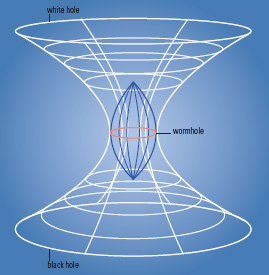String Theory: Difference between revisions
| Line 35: | Line 35: | ||
''See reference 2''. | ''See reference 2''. | ||
=== | ===Wormhole Diagram=== | ||
[[File:w-003.jpg]] | |||
==Connectedness== | ==Connectedness== | ||
Revision as of 03:40, 3 December 2015
Claimed by kjoshi39.
Introduction to String Theory
String theory is a theoretical framework aimed at addressing the short-comings of Einstein's Theory of General Relativity and quantum mechanics - the two primary sources of the current understanding of physics and the universe. String theory is often referred to as the theory of everything - a just identification given its ability to "fill in the gaps" between classical physics and quantum physics. The Theory of General Relativity and quantum mechanics are the primary, established explanations for the way the universe works on a macro and micro scale, respectively. However, these two physical explanations address different ends of the spectrum of matter, in terms of relativistic effects, fundamental forces, and physical properties. Specifically, string theory provides explanations where modern physics fails. These fields of interest include the early universe, black holes, and atomic nuclei. In order to understand the purpose of the theory of everything it is vital to have a rudimentary understanding of General Relativity's purpose as well as relativistic quantum mechanic's purpose - that is, in terms of gravitational affects on matter and the fundamental physics of the universe. General Relativity serves an important purpose to determine the gravitational affects on planetary-sized objects and observable particles, for example. However, the "gap" of Einstein's theory lies within its inability to address elementary particles. General Relativity successfully explains macro-scaled particles, given it's ability to incorporate gravitational affects. However, the same cannot be said for quantum-scale particles. Accordingly, these elementary particles require relativistic quantum mechanics to explain its physical properties, with the underlying assumption that gravity's affect on this scale is negligible. This is the disconnect between current physical two major schools of thought in modern physics. As a result, the purpose of the String theory is realized in its ability to successful incorporate gravitational affects, independent of the scale of particles. Thus, the theory of everything emerged.
Relevant Mathematical Equations (Bekenstein-Hawking Formula)
- [math]\displaystyle{ S= \frac{c^3kA}{4\hbar G} }[/math]
The Bekenstein-Hawking formula for entropy of a black hole, above, provides a theoretical value for the entropy of a black hole. While this equation provides an expected value that correlates to the entropy of a black hole according to macroscopic features resulting from its microstates, the formula lacks a derivation for a black hole's entropy based on counting microstates on a quantum-scale with consideration of gravitational aspects. Accordingly, in 1996, Andrew Strominger and Cumrun Vafa provided a derivation for a black hole's entropy with respect to the number of microstates of a black hole, and in terms of the string theory. The results obtained from these calculations provided solutions matching Berkenstein and Hawking's original formula. Thus, String Theory is validated as a mode of quantum gravity.
See reference 1.
Theoretical Foundation
String Theory is founded on the basis that elementary particles are components of strings that are microscopically small - to a degree that technology is not available to visualize this structure. A valid, and common, depiction of strings laced with elementary particles is to visualize these same particles lying on a violin string. String theory advocates believe that elementary particles are believed to be "excited" states due to vibrations in the string. The is a significant fact due to the bending of spacetime and production of black holes wormholes - solutions to Einstein's equations which are not explained entirely by quantum physics or general relativity in their own right. On a theoretical basis, string theory provides solutions based on gravity implemented on elementary particles (theory of quantum gravity), a unification of quantum mechanics and classical physics.
- include 10 dimensional information (reference 2)
See reference 2. How do we visualize or predict using this topic. Consider embedding some vpython code here Teach hands-on with GlowScript
Potential Discoveries and Applications
Wormholes
A potential usage of String Theory is to provide the quantum gravitational solutions that Einstein's theory fail to recognize at the center of black holes or worm holes. This inability is due to its lack of consideration quantum forces alongside gravity. The String Theory is integral to discovering wormholes' (derived solutions to Einsteins equations) level of stability. Specifically, String Theory's quantum forces and gravity enables the determination of the radiative affects and stability of these unexplained astrophysical phenomenon. In conclusion, these recently gained understandings of String Theory may ultimately yield answers to questions such as...
1. Given Kerr wormholes and their potential to connect distant points in the universe, is it theoretically feasible to use these solutions for traveling vast lengths through the universe?
See reference 2.
Wormhole Diagram
Connectedness
- How is this topic connected to something that you are interested in?
- How is it connected to your major?
- Is there an interesting industrial application?
History
Put this idea in historical context. Give the reader the Who, What, When, Where, and Why.
See also
Are there related topics or categories in this wiki resource for the curious reader to explore? How does this topic fit into that context?
Further reading
Books, Articles or other print media on this topic
External links
Internet resources on this topic
References
This section contains the the references you used while writing this page

